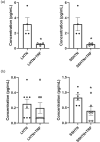Time restricted feeding decreases renal innate immune cells and blood pressure in hypertensive mice
- PMID: 35822591
- PMCID: PMC9444961
- DOI: 10.1097/HJH.0000000000003200
Time restricted feeding decreases renal innate immune cells and blood pressure in hypertensive mice
Abstract
Background: Renal innate immune cell accumulation and inflammation are associated with hypertension. Time restricted feeding (TRF) has been reported to decrease inflammation and blood pressure. Whether TRF can decrease blood pressure by decreasing renal innate immune cells in hypertension is unknown.
Methods and results: We determined whether TRF can decrease blood pressure in two separate mouse models of hypertension, N(G)-nitro-L-arginine methyl ester hydrochloride-induced hypertension (LHTN) and salt-sensitive hypertension (SSHTN). Once hypertension was established after 2 days, TRF (12-h food/12-h no food) for 4 weeks significantly decreased systolic blood pressure in both LHTN and SSHTN mice despite no differences in the amount of food eaten or body weight between groups. Activated macrophages and dendritic cells in the kidneys of both LHTN and SSHTN mice were decreased significantly in mice that underwent TRF. This was associated with an improvement in kidney function (decreased serum creatinine, decreased fractional excretion of sodium, and increased creatinine clearance) which achieved significance in LHTN mice and trended towards improvement in SSHTN mice.
Conclusions: Our findings demonstrate that TRF can significantly decrease renal innate immune cells and blood pressure in two mouse models of hypertension.
Copyright © 2022 The Author(s). Published by Wolters Kluwer Health, Inc.
Conflict of interest statement
There are no conflicts of interest.
Figures





Comment in
-
Impact of time-restricted feeding and circadian rhythm fasting on blood pressure.J Hypertens. 2022 Nov 1;40(11):2319-2320. doi: 10.1097/HJH.0000000000003275. J Hypertens. 2022. PMID: 36205016 No abstract available.
References
-
- Schiffrin EL. Inflammation, immunity and development of essential hypertension. J Hypertens 2014; 32:228–229. - PubMed
-
- Lopez Gelston CA, Mitchell BM. Recent advances in immunity and hypertension. Am J Hypertens 2017; 30:643–652. - PubMed
-
- Franco M, Martinez F, Quiroz Y, Galicia O, Bautista R, Johnson RJ, et al. Renal angiotensin II concentration and interstitial infiltration of immune cells are correlated with blood pressure levels in salt-sensitive hypertension. Am J Physiol Regul Integr Comp Physiol 2007; 293:R251–R256. - PubMed
-
- De Ciuceis C, Amiri F, Brassard P, Endemann DH, Touyz RM, Schiffrin EL. Reduced vascular remodeling, endothelial dysfunction, and oxidative stress in resistance arteries of angiotensin II-infused macrophage colony-stimulating factor-deficient mice: evidence for a role in inflammation in angiotensin-induced vascular injury. Arterioscler Thromb Vasc Biol 2005; 25:2106–2113. - PubMed
Publication types
MeSH terms
Substances
Grants and funding
LinkOut - more resources
Full Text Sources
Medical

